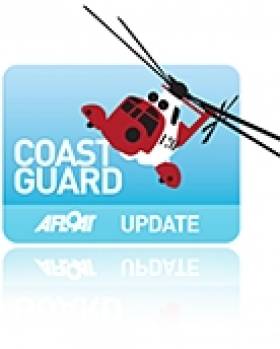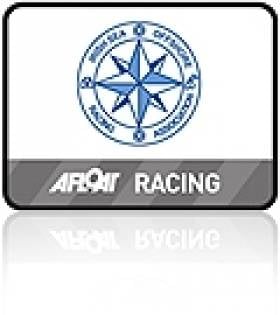Displaying items by tag: irish sea
Overdue Divers Rescued by Coastguard Helicopter
Liverpool Coastguard received a '999' call at 12:30 pm from the dive boat informing them of the situation and requesting assistance after two divers had not resurfaced and were last seen at 12 noon.
Drumore Coastguard Rescue team was tasked and the Portpatrick and Stranraer, RNLI lifeboats were requested to launch as well as the independent Port William inshore rescue boat. A Rescue helicopter from Prestwick was scrambled to the scene. The vessel 'Go West' assisted in the search.
Paul Campbell, Watch Officer, Liverpool Maritime and Rescue Coordination Centre, said:
"Once the casualty vessel was located the search and rescue units on scene carried out a search around the Mull of Galloway Lighthouse with the Rescue helicopter locating the two casualties and winching them to safety."
The Coastguard always advises divers to let the Coastguard know where and when you will be diving. Always keep a close eye on the weather and sea conditions and make personal fitness a top priority for safe diving. Familiarise yourself with new or different gear before diving and ensure that you dive within your limits.
ISORA Race Five Comes to Abrupt End
From an entry list of 27 sailing boats, 16 boats came to the line in Dun Laoghaire for the 5th ISORA race and first Sunday Race. Peter Ryan reports. It was hoped that this format would encourage those boats that regularly compete in the Dublin Bay and Howth racing and are reluctant to take part in ISORA as they would lose points in their Series. Unfortunately, this did not happen. We did not have any new boats competing.
The day looked ideal based on the weather forecast – 14kts West veering North West. With north-going spring tides the course selected was: Lambay (P)- Rockabill (S)- Kish (P) and to the finish. The course ensured that the fleet would have the tide with them all along the course. This was the only factor that remained constant.
The fleet left Dun Laoghaire in the 14kts westerly and made good progress across the bay towards the Bailey until it fell into a huge hole at the Bailey. For 30 minutes the only movement was the 1.5kt tide going north. Most of the fleet kept close to the shore while "Galileo" and "Tsunami" stayed out in the tide. At one time the shore side boats appeared to move again only to stop again. The wind filled in giving "Galileo" and "Tsunami" the advantage. "Intuition" was the lead shore boat and it also got the early wind. The wind had veered to the north-west and it was a fetch to Rockabill.
"Galileo" was first around Roackabill followed closely by "Intuition", Tsunami" and "Rebellion". The remainder of the fleet were well bunched close behind. Most of the run to Kish was in ideal sailing weather – moderate winds, sunshine, warm etc. This came to an abrupt end when the leaders were approaching Kish. A squall came through causing a rapid dropping of kites for the last mile. The same placings occurred at Kish as it was at Rockabill.
It was a beat to the finish. The wind had again dropped back to the 15kts after the squall. This left boats wondering if changing back up to the No.1's was required. The answer was not long in coming. A very strong squall hit the fleet with winds in excess of 28kts with driving rain sending boats scattering across Dublin Bay.
The first boat to cross the finish line was "Galileo", who only managed to take 2nd Overall and 2nd in Class 1. It was followed closely by "Intuition" who took 1st in both Overall and Class 1. "Tsunami" was next over the line to take 3rd in Class1 and 4th Overall. "Mojito" sailing two-handed took 3rd Overall and 1st in Class2. Another two-handed "Dinah" took 2nd Class2 while "Lula Belle" took 3rd Class2.
I would like to thank Larry Power of the National Yacht Club for doing the start and Chris Moore for recording the finishers. An "Après Sail" took place in the NYC after where the provisional results were announced.
The next race is on the 23rd July with the ISORA / RAYC / Lee Overlay Night Race to North India.
'Captain Calamity' Rescued Twice in Two Days
A lone sailor in the Irish Sea who was rescued south of Mumbles yesterday with no power and almost no safety equipment on board has just been rescued again after setting out for the second time and once again losing engine power, this time off Rhoose Point.
At quarter past eight yesterday the male on board the yacht 'Stravaig' contacted Swansea Coastguard to inform them that he had lost all electrical power and was drifting nine miles south of Mumbles Head. The man had no navigation lights, and only a mobile phone with a very low battery as a communications device. The only navigational equipment he had was a handheld GPS which also was very low on battery.
The Mumbles RNLI lifeboat was launched to the 12 metre yacht and towed her in to Mumbles. A second lifeboat also assisted with her mooring.
Almost exactly 24 hours later, at ten past eight this evening, Swansea Coastguard received another call from the same yacht, reporting that it had again run out of power. This time the Barry Dock lifeboat has been sent to tow the vessel back in to Barry. Barry Coastguard Rescue Team will meet the vessel in order to give the sailor advice on how to safely continue his journey.
Dave Jones, Swansea Coastguard Watch Manager said:
"When we give out safety advice to people going out for a trip in a yacht we recommend that people take adequate communications and navigational devices, flares, and check their engines. Unfortunately, this man followed none of this advice and set out not once, but twice, knowing that he did not have sufficient power to reach his destination.
All of the rescue resources tasked to this man's two rescues have been volunteers and we hope that the yachtsman will consider full equipping and preparing his vessel before continue his journey in order that we do not have to send them out to his rescue for a third time."
Swansea Lifeboat in Multiple Rescues
The warm weather has brought on a string of incidents for Swansea Coastguard, who this afternoon have co-ordinated several rescues, including three missing children, a capsized kayak and an injured jet-skier.
Several resources in particular were sent by Swansea Coastguard to assist in the search for a 5-year-old girl at Burnham-on-Sea beach this afternoon. The girl was reported missing via a 999 call to the Coastguard made by her father at 20 past 2. Swansea Coastguard sent Coastguard Rescue Teams from Burnham-on-Sea and Weston Super Mare, as well as the Burnham Hovercraft, Avon and Somerset Police (including their helicopter), and the two Burnham RNLI inshore lifeboats to perform a shoreline search at Berrow at Burnham-on-Sea.
After an hour-and-a-half of searching the girl was located by Police units who found the girl with a beach warden and returned her safely to her family.
Swansea Coastguard also co-ordinated the searches of a missing 6-year-old girl this morning, also at Burnham, and a missing 5-year-old boy at Rhossili.
In other incidents, a kayaker was rescued by the Mumbles RNLI lifeboat after capsizing and Rhossili Coastguard Rescue Team were sent to the rescue of a female seriously injured in a jet ski incident on the beach at Port Eynon, Gower. The Coastguards assisted paramedics to evacuate the female onto the air ambulance, where she was taken to hospital.
Swansea Coastguard Watch Manager Dai Jones said:
“We have had an extremely busy afternoon, with many incidents brought on by the warm weather. We would like to remind members of the public to be vigilant when taking children to the beach as, on days like this when the beaches are packed with people, it only takes a child to disappear from view for a second before they can become lost.”
From an entry list of 30 sailing boats, 19 boats came to the line in Holyhead for the 3rd ISORA race – 75 miles to Dun Laoghaire. The fleet, that was missing many of their “regulars” had four newcomers to ISORA - “Mojito”, Peter Dunlop, “Poppy of St. Helier”, John Roberts (another John Roberts), “Intuiition” and “One Life”, both of Sailing West Sailing School.
There were two significant predicted factors affecting the race – the extremely strong Spring Tides and a wind shift from northwest to southwest during the race. As forecast the wind was 12knots northwest at the start and immediately the fleet split into two halves. The main fleet headed south plugging the north going tide while a small bunch headed north using the strong tide.
The wind followed its forecast and backed south-west although the north part of the fleet were lifted onto Rockabill, the wind was stronger for the south fleet who arrived under spinnaker.
Despite this the entire fleet, closely bunched met again at Rockabill. “Tsunami”, Vincent Farrell, who was part of the north fleet, round first, followed closely by “Raging Bull” Matt Davis and “Intuition”, Sailing West Sailing School, both of whom were part of the south fleet. The strong tide had just turned to go north as the fleet rounded and made their way to Kish.
The wind, that had been very fickle at Rockabill increased to 20 knots shortly after the leaders rounded Rockabill and it was a beat to Kish. The wind had not finished its gyrations and the fleet experienced a huge wind shift off Lambay. This shift enabled those who had gone towards the coast to crack off and reach to Kish while those who stayed out fetched to the mark.
Despite this the leader order of rounding the Kish was the same as rounding of Rockabill. The new wind direction produced a beat from Kish to the finish with the wind reducing to 7 knots at the finish. The first boat to cross the finish line was “Tsunami”, who only managed to take 2nd in Class 1. It was followed closely by Matt Davis’s “Raging Bull” who won Class 1. “Intuition”,
Sailing West Sailing School, crossed the line 3rd to take 3rd in Class 1. Class 2 was won by “Poppy” followed by “Mojito” and “Just Enough”, Stephen Tudor.
Class 2 boats dominated the overall results with the same boats winning the overall positions.
As newcomers to ISORA, “Poppy” and “Mojito” have really made a huge impact in their inaugural race and ISORA's hope is their presence can be repeated on the ISORA start line in the future. The next race is next weekend 5th June from Pwllheli to Wicklow. It is another 75- mile race.
UK J80 Nationals Take Place on the Irish Sea
The Tacktick Suunto J/80 UK National Championship 2010 commences this week. The event will be hosted by the Cardiff Bay Yacht Club from Wednesday 5th May to Saturday 8th of May. Racing will take place in the Bristol Channel under the watchful eye of PRO David Cairncross and J/80 teams have travelled from all around the UK to comptete. The J/80 is the fastest selling sportsboat in Europe and the class is delighted that marine electronics specialists Tacktick Suunto are sponsoring the event. Ireland has 13 of these keelboats but sadly none are competing in Cardiff.
The competition in Cardiff will be hotly fought; alongside the travellers there will be a strong local field of five J/80 teams. J/80 International Class Chairman, Steve Cooper, will be competing in Junior High. Steve and his team are well travelled J/80 sailors and were part of the huge World Championship fleet at Santander last year. Local knowledge pays and we may see Junior High come of age this year. Scott Cole and his team on Purple Haze also from Cardiff, are known to be fast and both these boats know the sailing area well.
Toe In The Water, a charity that aims to encourage and rehabilitate injured servicemen and women through the sport of sailing, have four boats entered in the regatta. The relationship between the charity and the UK J/80 Class has been established for over three years now. Whilst these crews don’t get to sail with each other as frequently as many of the others at the Nationals, in the past the Toe In The Water teams have proved tactically strong and have shown skilful boat handling as well as pace.
The British Keelboat Academy will be represented at the Tacktick Suunto J/80 Nationals by Tom Phipps and Kelvin Matthews. These lads slotted in some really strong results at the championships in 2009 and will be well worth watching. The Britannia Royal Naval College will also be racing for the Championship title in J/80 Wave Warrior skippered by Joe Henry.
From the Solent, Thor Askeland makes his J/80 National Championship debut, racing Elle S’Apelle. Thor won the Autumn Champs in Hamble last year and has shown more than a few moments of brilliance throughout the spring season. He will be looking for consistency at the Nationals and for a podium finish. Terry Palmer (J/80 UK Class Chairman) and Caroline Cooper slotted in a top three result in the 93 boat J/80 fleet at Spi Ouest earlier this year, racing Just Do It. They will perhaps be hoping for similar windy conditions in Wales this week; they know they are quick in the big breeze. Ian Atkins will also be making the trip to Cardiff; having won five out of seven races sailed last weekend in his local series, Ian and his crew on Boats.com will have silverware their sights next week.
Racing at the Tacktick Suunto J/80 UK National Championship 2010 starts on Thursday. A full programme is planned on and off the water. It will be and extremely exciting and lively week!

































































